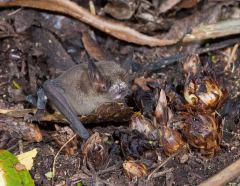
WTF? © P. Bendle
Sounds like a Monty Python sketch, doesn’t it? But no, it’s about the wonderful complexity of ecology.
An interesting, and very weird paper just came out in Conservation Biology co-authored by my friend and colleague, Prof. Alan Cooper at the Australian Centre for Ancient DNA (ACAD).
Here’s what they have to say about it.
–
Ancient dung from a cave in the South Island of New Zealand has revealed a previously unsuspected relationship between two of the country’s most unusual threatened species.
Fossilised dung (coprolites) of a now rare parrot, the nocturnal flightless kakapo, contained large amounts of pollen of a rare parasitic plant, Dactylanthus, which lives underground and has no roots or leaves itself. The pollen suggests the kakapo was formerly an important pollinator for the threatened species, known as the Hades flower or wood rose. Researchers from the Australian Centre for Ancient DNA at The University of Adelaide, and Landcare Research and the Department of Conservation in New Zealand report the discovery in the journal Conservation Biology.
Lead researcher, Dr Jamie Wood, said “Coprolites are one of the only ways to reconstruct important pre-human ecological relationships, such as pollination and seed dispersal, which must be restored to conserve these species over the long term”. The team is funded by a New Zealand Marsden grant to study the pre-human ecosystem using preserved coprolites from caves and rockshelters across New Zealand.
Dr Janet Wilmshurst from Landcare Research, added “Dactylanthus is now restricted to around 4 % of its pre-human range, due to forest clearance, predation by introduced mammals and a lack of pollinators and seed dispersers. The range has decreased a lot even since the 1970s and only scattered populations now survive in the North Island and offshore islands”.

Pollen-slathered lesser short-tailed bat
The musky sweet smell and copious nectar of the Dactylanthus flower attracts the only remaining known native pollinator, the endangered New Zealand lesser short-tailed bat, which forages extensively on the forest floor. However, it is also highly attractive to introduced possums and rats, which eat the flowers.
Kakapo are extinct from mainland New Zealand and their recent introduction to the island sanctuary of Hauturu/Little Barrier Island, where Dactylanthus survives, has re-united the two species for the first time in potentially a century.
ACAD Director, Prof. Alan Cooper, explained “this is an important example of an apparent tight co-evolutionary relationship between threatened endemic species – the plant and burrowing bat – simply representing ‘the last men standing’. The coprolites suggest that the kakapo also served as pollinators, potentially along with other species, which is critical information for conservation. It also emphasises the wide range of ecosystem links that are broken in post-human environments”.
-34.917731 138.603034
